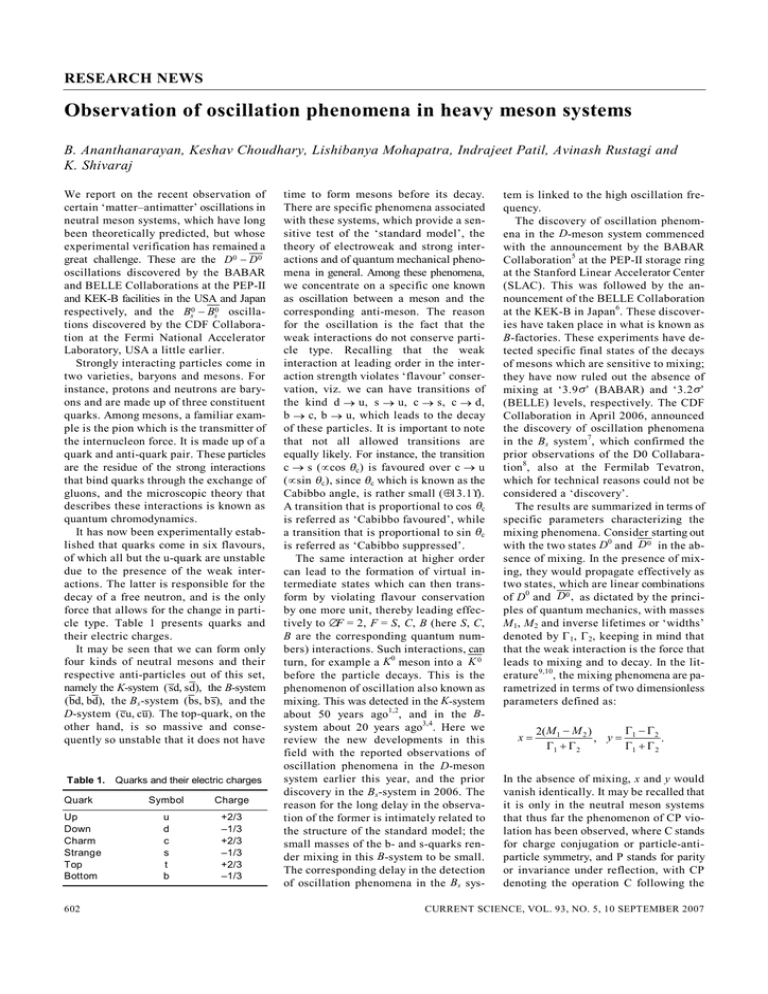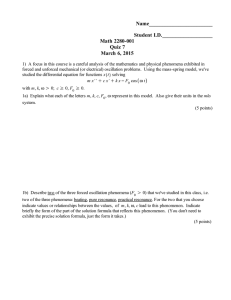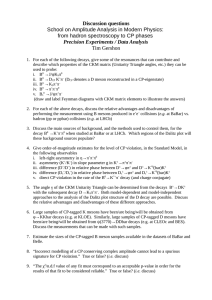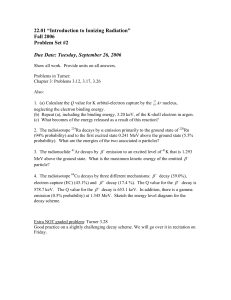Observation of oscillation phenomena in heavy meson systems RESEARCH NEWS
advertisement

RESEARCH NEWS Observation of oscillation phenomena in heavy meson systems B. Ananthanarayan, Keshav Choudhary, Lishibanya Mohapatra, Indrajeet Patil, Avinash Rustagi and K. Shivaraj We report on the recent observation of certain ‘matter–antimatter’ oscillations in neutral meson systems, which have long been theoretically predicted, but whose experimental verification has remained a great challenge. These are the D 0 − D 0 oscillations discovered by the BABAR and BELLE Collaborations at the PEP-II and KEK-B facilities in the USA and Japan respectively, and the Bs0 − Bs0 oscillations discovered by the CDF Collaboration at the Fermi National Accelerator Laboratory, USA a little earlier. Strongly interacting particles come in two varieties, baryons and mesons. For instance, protons and neutrons are baryons and are made up of three constituent quarks. Among mesons, a familiar example is the pion which is the transmitter of the internucleon force. It is made up of a quark and anti-quark pair. These particles are the residue of the strong interactions that bind quarks through the exchange of gluons, and the microscopic theory that describes these interactions is known as quantum chromodynamics. It has now been experimentally established that quarks come in six flavours, of which all but the u-quark are unstable due to the presence of the weak interactions. The latter is responsible for the decay of a free neutron, and is the only force that allows for the change in particle type. Table 1 presents quarks and their electric charges. It may be seen that we can form only four kinds of neutral mesons and their respective anti-particles out of this set, namely the K-system (sd, sd), the B-system (bd, bd), the Bs -system (bs, bs), and the D-system (cu, cu). The top-quark, on the other hand, is so massive and consequently so unstable that it does not have Table 1. Quarks and their electric charges Quark Up Down Charm Strange Top Bottom 602 Symbol Charge u d c s t b +2/3 –1/3 +2/3 –1/3 +2/3 –1/3 time to form mesons before its decay. There are specific phenomena associated with these systems, which provide a sensitive test of the ‘standard model’, the theory of electroweak and strong interactions and of quantum mechanical phenomena in general. Among these phenomena, we concentrate on a specific one known as oscillation between a meson and the corresponding anti-meson. The reason for the oscillation is the fact that the weak interactions do not conserve particle type. Recalling that the weak interaction at leading order in the interaction strength violates ‘flavour’ conservation, viz. we can have transitions of the kind d → u, s → u, c → s, c → d, b → c, b → u, which leads to the decay of these particles. It is important to note that not all allowed transitions are equally likely. For instance, the transition c → s (∝cos θ c) is favoured over c → u (∝sin θ c), since θ c which is known as the Cabibbo angle, is rather small (≈13.1°). A transition that is proportional to cos θc is referred as ‘Cabibbo favoured’, while a transition that is proportional to sin θ c is referred as ‘Cabibbo suppressed’. The same interaction at higher order can lead to the formation of virtual intermediate states which can then transform by violating flavour conservation by one more unit, thereby leading effectively to ∆F = 2, F = S, C, B (here S, C, B are the corresponding quantum numbers) interactions. Such interactions, can turn, for example a K0 meson into a K 0 before the particle decays. This is the phenomenon of oscillation also known as mixing. This was detected in the K-system about 50 years ago1,2, and in the Bsystem about 20 years ago3,4. Here we review the new developments in this field with the reported observations of oscillation phenomena in the D-meson system earlier this year, and the prior discovery in the Bs -system in 2006. The reason for the long delay in the observation of the former is intimately related to the structure of the standard model; the small masses of the b- and s-quarks render mixing in this B-system to be small. The corresponding delay in the detection of oscillation phenomena in the Bs sys- tem is linked to the high oscillation frequency. The discovery of oscillation phenomena in the D-meson system commenced with the announcement by the BABAR Collaboration5 at the PEP-II storage ring at the Stanford Linear Accelerator Center (SLAC). This was followed by the announcement of the BELLE Collaboration at the KEK-B in Japan6. These discoveries have taken place in what is known as B-factories. These experiments have detected specific final states of the decays of mesons which are sensitive to mixing; they have now ruled out the absence of mixing at ‘3.9σ’ (BABAR) and ‘3.2σ’ (BELLE) levels, respectively. The CDF Collaboration in April 2006, announced the discovery of oscillation phenomena in the Bs system7, which confirmed the prior observations of the D0 Collabaration8, also at the Fermilab Tevatron, which for technical reasons could not be considered a ‘discovery’. The results are summarized in terms of specific parameters characterizing the mixing phenomena. Consider starting out with the two states D0 and D 0 in the absence of mixing. In the presence of mixing, they would propagate effectively as two states, which are linear combinations of D0 and D0 , as dictated by the principles of quantum mechanics, with masses M 1, M 2 and inverse lifetimes or ‘widths’ denoted by Γ1, Γ2, keeping in mind that that the weak interaction is the force that leads to mixing and to decay. In the literature 9,10, the mixing phenomena are parametrized in terms of two dimensionless parameters defined as: x= Γ − Γ2 2( M 1 − M 2 ) , y= 1 . Γ1 + Γ 2 Γ1 + Γ 2 In the absence of mixing, x and y would vanish identically. It may be recalled that it is only in the neutral meson systems that thus far the phenomenon of CP violation has been observed, where C stands for charge conjugation or particle-antiparticle symmetry, and P stands for parity or invariance under reflection, with CP denoting the operation C following the CURRENT SCIENCE, VOL. 93, NO. 5, 10 SEPTEMBER 2007 RESEARCH NEWS Figure 1. Figure 2. Right-sign and wrong-sign events without the oscillation D 0 → D 0 . + – Cabibbo favoured decay of D 0 meson, after oscillation, going to K π . operation P. It turns out that many of the CP violating observations are intimately linked to the phenomena of mixing which have been observed in the K- and B-systems. However, in the two most recent discoveries, this phenomenon is essentially absent, thereby simplifying the analysis of the oscillation phenomena. The BABAR detector at PEP-II storage rings at SLAC announced the evidence for D 0 − D 0 mixing in D0 → K+π– decays from 348 fb–1 of e– e+ colliding beam data recorded near s = 10.6 GeV ( s is the total energy in the centre of mass frame of e– and e+ and fb–1 stands for inverse femtobarn, a standard unit of luminosity). The BABAR Collaboration based its report on the observation of ‘right-sign’ (RS) and ‘wrong-sign’ (WS) events in the final state Kπ. The corresponding decays are shown in Figures 1 and 2. The BABAR Collaboration focussed on the WS decay D0 → K+π–, which bears the imprint of mixing. The desired ‘wrong state’ K+π– can be obtained in two ways: (a) through Doubly Cabbibo Suppressed (DCS) decay and (b) through Cabibbo Favoured (CF) decay after oscillating to D 0 . Each of these two con- tributions to the WS decays provides a different time dependence to the decay rates which the experiment measures. D0 and D 0 are distinguished by their production in the decay D *+ → π s+ D 0 , where π s+ is referred to as ‘slow pion’. Here D*+ is an excited state of D+. Thus, the RS and WS decays are: D *+ → π s+ D 0 → π s+ K −π + → π s+ K +π − (RS) (WS). In RS decay, π s+ and kaon have opposite charges, while in the WS decay π s+ and kaon have the same charge. Time dependence of the WS decay rate is used to separate DCS decays from D 0 − D 0 mixing. The BABAR Collaboration analysed 1,141,500 ± 1200 RS signal events and 4030 ± 90 WS signal events. Data were analysed in terms of parameters x′ and y′, where they are related to x and y by a strong phase ( δ ) associated with the rescattering of the πK pair in the final state, and the relations are, x′ = x cos δ + y sin δ, y′ = y cos δ – x sin δ. CURRENT SCIENCE, VOL. 93, NO. 5, 10 SEPTEMBER 2007 The measured values are, y′ = [9.7 ± 4.4(stat) ± 3.1(syst)] × 10–3 x′ 2 = [–0.22 ± 0.30(stat) ± 0.21(syst)] × 10–3. This result is inconsistent with the nomixing hypothesis with a significance of 3.9σ. The BELLE Collaboration based their results on 540 fb–1 of data recorded at KEK-B asymmetric-energy collider. Their idea was based on the fact that if there is oscillation then there will be a time difference between decays D0 → K– π+, D0 → K+K– , and D0 → π+π– . Using the fact that there was no evidence for CP violation, the BELLE Collaboration was able to measure the lifetime difference of D0 mesons between these decays to be, yCP = (1.31 ± 0.32(stat) ± 0.25(syst)) × 10–2, yCP ≡ τ ( K −π + ) − 1, τ (K + K − ) where τ(K– π+) and τ(K+K– ) are the lifetimes D0 → K– π+ and D0 → K+K– respec603 RESEARCH NEWS tively, and yCP equals y in the limit of CP conservation. Thus the BELLE Collaboration result differs from zero by 3.2σ. Non-zero lifetime difference between different decay modes represents clear evidence for transformation of the D0 particle into its anti-particle. Therefore, both BABAR and BELLE Collaborations are able to show that there is oscillation in D-systems and they did not observe any CP violation. It is partly because of the limitation on the sensitivity of the experiments. The new experiments with higher accuracy could reveal the fate of CP violation in Dsystems. Turning now to the oscillation phenomena in the Bs -system, these have been observed by the CDF Collaboration by considering the Bs hadronic decays Bs0 → Ds+π − and Ds+π −π +π − , and the semileptonic decays Bs0 → Ds+ (*) l − ν l , l = e or µ. Using the probability density functions that describe the measured time development of Bs mesons that decay with the same or opposite flavour as their flavour at production, they have measured the value of ∆ms (oscillation frequency). The measured ∆ms = 17.77 ± 0.10(stat) ± 0.07(syst) ps–1 with more than 5σ confidence level. In summary, we have reviewed the recent experimental discoveries of oscillation phenomena in the two neutral systems where the effects are hardest to observe. In the coming years the oscillation parameters are likely to be wellmeasured and CP violation may be seen. A large signal for CP violation in these neutral meson systems would imply the presence of interactions beyond those described by the standard model. 1. Lande, K., Booth, E. T., Impeduglia, J., Lederman, L. M. and Chinowsky, W., Phys. Rev., 1956, 103, 1901–1904. 2. Fry, W. F., Schneps, J. and Swami, M. S., Phys. Rev., 1956, 103, 1904–1905. 3. Albajar, C. et al., Phys. Lett. B, 1987, 186, 247–254; ibid., Erratum, 1987, 197, 565. 4. Albrecht, H. et al., Phys. Lett. B, 1987, 192, 245–252. 5. Aubert, B. et al., Phys. Rev. Lett., 2007, 98, 211802-1–211802-7. 6. Staric, M. et al., Phys. Rev. Lett., 2007, 98, 211803-1–211803-6. 7. Abulencia, A. et al., Phys. Rev. Lett., 2006, 97, 242003-1–242003-8. 8. Abazov, V. M. et al., Phys. Rev. Lett., 2006, 97, 021802-1–021802-7. 9. Ball, P., arXiv:hep-ph/0703245, pp. 1–6. 10. Nir, Y., J. High Energy Phys., 2007, 705, 102-1–102-14. B. Ananthanarayan* and K. Shivaraj are in the Centre for High Energy Physics, Indian Institute of Science, Bangalore 560 012, India; Keshav Choudhary, Lishibanya Mohapatra and Avinash Rustagi are in the Department of Physics, St. Stephen’s College, Delhi 110 007, India; Indrajeet Patil is in the Department of Physics, Fergusson College, Pune 411 004, India. *e-mail: anant@cts.iisc.ernet.in Orchids practice deception Pooja Muralidharan The plant–animal interaction is one of the most fascinating sub-disciplines of biology, which has drawn the attention of researchers. The animals often act as dispersal agents of pollination1. The pollination system that exists in the insect (bee) pollinated orchid of the genus Ophrys is fascinating. The structural specialization seen in orchids belonging to the family Orchidaceae, instegates pollination by its specific pollinator species (bees) 1. According to Ledford2, the orchid discharges a scent which mimics the female sex pheromones offering a fallacious promise of sex to male bees (Andrena). The promise of quick profits allure the unwary visitor bee2. The bee, responding to the inviting waves of overwhelming scent, approaches the flower with a desire of finding a mate. However, the bee is taken by surprise when it finds a flower instead. Hence, the bee in its attempt to copulate the flower, adheres large packs of sticky pollen to its head and abdomen. The bee then flies-off in an attempt to look for its 604 real mates. The process is repeated in another patch of the same orchid species, that is eventually pollinated. Hence the bee is a pollinator. The evolution of this type of deception in some species of orchids is speculated to be due to the high cost of production of the energy-rich nectar reward2. The orchid flower is bilaterally symmetrical. The basic orchid flower is composed of three sepals in the outer whorl and three petals in the inner whorl. The medial petal called labellum or lip is modified and enlarged. This serves to attract insects that pollinate the flower and acts as a landing platform for them. Deception techniques in orchids that belong to the genus Ophrys can vary2. As noted earlier, there are orchids that reward the pollinator with nectar. However, there are orchids that deceive pollinators (bees) with their appearance, smell and texture. The deception usually involves mimicking a female partner, for example, a female bee. Hence, by a combination of visual, olfactory and tactile cues, the bees are deceived to act as pollinating agents for orchids (Figure 1). Figure 1. An orchid flower that mimics a female bee using visual or olfactory signals. (Reference: http://www.blackwatervalley.org.uk/bee_orchid.htm; Source: Alan Eggleton for Blackwater Valley Countryside Partnership.) CURRENT SCIENCE, VOL. 93, NO. 5, 10 SEPTEMBER 2007







